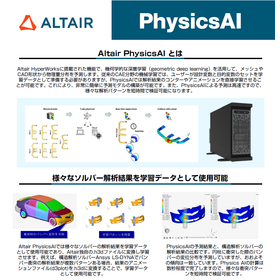Here is an example of a comparison between the obtained reflection coefficient from the analysis results and the theoretical values!
When a dielectric such as polyethylene is filled in a rectangular waveguide, reflections of electromagnetic waves occur at the air interface. Considering a system where polyethylene is filled in part of a rectangular waveguide of standard WRJ-5, the distribution of electromagnetic waves was analyzed using the finite element method. As a result, it was found that the absolute value of the electric field on the polyethylene side is constant, indicating that no reflection occurs at the output surface (the impedance boundary is correctly set). [Case Summary] ■ Analysis Module: PHOTO-WAVEjω ■ Analysis Results - It is evident that no reflection occurs at the output surface since the absolute value of the electric field on the polyethylene side is constant (the impedance boundary is correctly set). - In the calculation of the scattering matrix, the characteristic impedances of air and polyethylene were set as ZAir = 279.052Ω and ZPE = 156.987Ω. *For more details, please refer to the related links or feel free to contact us.
Inquire About This Product
basic information
[Analysis Conditions] ■ Set the electric field of the TE10 mode with a maximum value of 1 V/m at the air side port (Port 1) as the loading condition. ■ Apply symmetric boundary conditions on all sides of air and polyethylene, and impedance boundary conditions on the surface where electromagnetic waves are output. ■ Frequency: 5.00 GHz *For more details, please refer to the related links or feel free to contact us.
Price range
Delivery Time
Applications/Examples of results
For more details, please refer to the related links or feel free to contact us.
Company information
At Photon, we are developing "electromagnetic field analysis software" that models and simulates products and components utilizing electromagnetic phenomena on a computer. In traditional design and development environments, the process has primarily revolved around trial and error through prototyping based on the experience of engineers and experiments with prototypes. However, conducting experiments using actual prototypes and analyzing the results requires significant time and cost. Moving forward, transitioning from an experimental and prototyping-based approach to an analysis-based design approach will be a crucial challenge for improving productivity, and establishing simulation technology as the core of analysis-based design techniques will be essential. In this context, Photon is developing and providing "analysis software" focusing on electromagnetic fields, as well as heat, vibration, and sound fields. By utilizing Photon's software, efficient development and design of various industrial products can be achieved. In this way, Photon aims to support users in reducing the number of prototypes, lowering development costs, and shortening development periods in their manufacturing environments, ultimately enhancing their competitiveness.



![[Analysis Case] Electric Field Analysis of Cylindrical Capacitor (Capacitance Calculation)](https://image.mono.ipros.com/public/product/image/67c/2000766437/IPROS55160931710849536106.png?w=280&h=280)







![SOLIDWORKS 2026 New Features Seminar [Free Participation]](https://image.mono.ipros.com/public/default/object/noimage_l.gif?w=280&h=280)